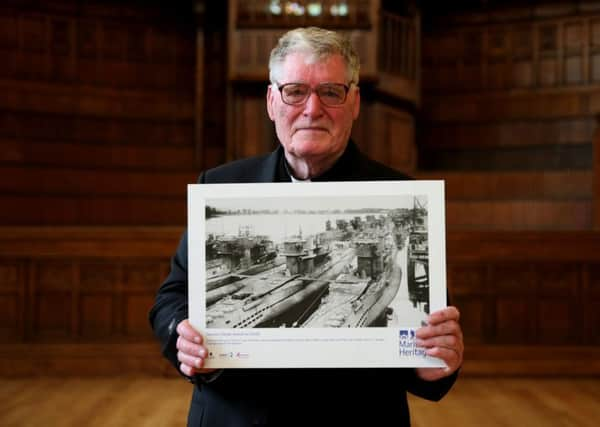Priest recalls surrender of Hitler’s U-boats in Londonderry


Fr Arthur O’Reilly, then aged 13, marvelled at the clarity of vision as he examined the unsuspecting people walking on the quay.
On a break between exams he had scrambled through narrow compartments of the submarine, past signs bearing the warning “Achtung”.
Advertisement
Hide AdAdvertisement
Hide AdTorpedoes had been decommissioned and the crew already transported to an Army camp in Co Down leaving their deadly watercraft moored on the banks of the River Foyle in Londonderry at the end of the Second World War 70 years ago this weekend.
Fr O’Reilly said: “It was very sad that there was such loss of life. It was a tragic consequence of the war and the belligerence between nations.
“It was a great feeling that the war was over and that there would be no more destruction or loss of life, at least that was a consolation.”
Londonderry was once one of the command centres, close to the Atlantic’s Western Approaches where so-called “wolf-packs” of the stealthy underwater machines had wrought such damage on British shipping. The city is marking the anniversary of the German capitulation with a festival of film and old memorabilia.
Advertisement
Hide AdAdvertisement
Hide AdAmong the artefacts are a set of dark green binoculars captured from a submarine, photographs of German naval men at recreation, an accordion in hand, and of submarines tied up in the city.
Fr O’Reilly, now a sprightly octogenarian living near Londonderry, said a British naval officer showed him around.
“He allowed me to look through the periscope and I could see people walking on the quay. You could identify people, I was amazed at the technology, you could see people’s features.”
He said the U-boat was small and confined.
“I wondered how did they fit 30 personnel into the small space.
Advertisement
Hide AdAdvertisement
Hide Ad“They shared the bunks (between shifts), there was a shelf between each compartment, with signs saying “Achtung”.
“The shelf was to prevent flooding, you had to step over it, there were these apertures from one section to the next.
“I saw the torpedo bays, they were deactivated at that time, I saw the navigation instruments - it was very exciting for a schoolboy to see all these things that you had read about in the papers and heard on the radio.”
The Battle of the Atlantic, a competition of blockades, finally ended with the conclusion of the Second World War and the surrender of German U-boats which battered Allied defences and disrupted the shipping of supplies for over six years.
Advertisement
Hide AdAdvertisement
Hide AdFr O’Reilly said submariners had often behaved ethically, rescuing survivors of torpedo strikes, and few were infected by Nazism.
On May 14, 1945 the first of the German craft made their way up the Foyle to the port of Lisahally where they were formally ordered to surrender by Admiral Sir Max Horton, Commander-in-Chief, Western Approaches.
The ceremony acknowledged Londonderry’s pivotal role as a strategic allied base, with over 100 military ships docked there from 1943, allowing control of the Atlantic sea lanes and playing a key role in the 1944 invasion of France, a local historian said.
Margaret Edwards, from Derry and Strabane District Council’s Museums Service, said: “For Sir Max Horton to come here to accept that surrender put Derry on the map as a place that had to be remembered for the role it played.”